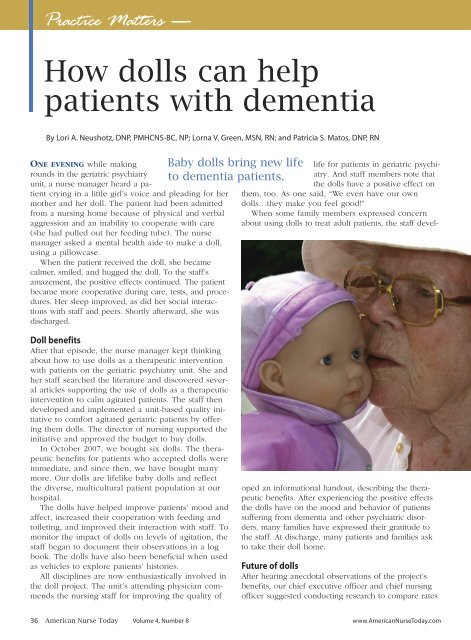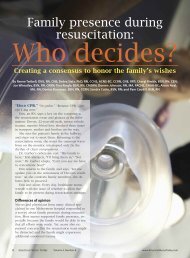How dolls can help patients with dementia - American Nurse Today
How dolls can help patients with dementia - American Nurse Today
How dolls can help patients with dementia - American Nurse Today
Create successful ePaper yourself
Turn your PDF publications into a flip-book with our unique Google optimized e-Paper software.
Practice Matters —<br />
<strong>How</strong> <strong>dolls</strong> <strong>can</strong> <strong>help</strong><br />
<strong>patients</strong> <strong>with</strong> <strong>dementia</strong><br />
By Lori A. Neushotz, DNP, PMHCNS-BC, NP; Lorna V. Green, MSN, RN; and Patricia S. Matos, DNP, RN<br />
ONE EVENING while making<br />
rounds in the geriatric psychiatry<br />
unit, a nurse manager heard a patient<br />
crying in a little girl’s voice and pleading for her<br />
mother and her doll. The patient had been admitted<br />
from a nursing home because of physical and verbal<br />
aggression and an inability to cooperate <strong>with</strong> care<br />
(she had pulled out her feeding tube). The nurse<br />
manager asked a mental health aide to make a doll,<br />
using a pillowcase.<br />
When the patient received the doll, she became<br />
calmer, smiled, and hugged the doll. To the staff’s<br />
amazement, the positive effects continued. The patient<br />
became more cooperative during care, tests, and procedures.<br />
Her sleep improved, as did her social interactions<br />
<strong>with</strong> staff and peers. Shortly afterward, she was<br />
discharged.<br />
Baby <strong>dolls</strong> bring new life<br />
to <strong>dementia</strong> <strong>patients</strong>.<br />
Doll benefits<br />
After that episode, the nurse manager kept thinking<br />
about how to use <strong>dolls</strong> as a therapeutic intervention<br />
<strong>with</strong> <strong>patients</strong> on the geriatric psychiatry unit. She and<br />
her staff searched the literature and discovered several<br />
articles supporting the use of <strong>dolls</strong> as a therapeutic<br />
intervention to calm agitated <strong>patients</strong>. The staff then<br />
developed and implemented a unit-based quality initiative<br />
to comfort agitated geriatric <strong>patients</strong> by offering<br />
them <strong>dolls</strong>. The director of nursing supported the<br />
initiative and approved the budget to buy <strong>dolls</strong>.<br />
In October 2007, we bought six <strong>dolls</strong>. The therapeutic<br />
benefits for <strong>patients</strong> who accepted <strong>dolls</strong> were<br />
immediate, and since then, we have bought many<br />
more. Our <strong>dolls</strong> are lifelike baby <strong>dolls</strong> and reflect<br />
the diverse, multicultural patient population at our<br />
hospital.<br />
The <strong>dolls</strong> have <strong>help</strong>ed improve <strong>patients</strong>’ mood and<br />
affect, increased their cooperation <strong>with</strong> feeding and<br />
toileting, and improved their interaction <strong>with</strong> staff. To<br />
monitor the impact of <strong>dolls</strong> on levels of agitation, the<br />
staff began to document their observations in a log<br />
book. The <strong>dolls</strong> have also been beneficial when used<br />
as vehicles to explore <strong>patients</strong>’ histories.<br />
All disciplines are now enthusiastically involved in<br />
the doll project. The unit’s attending physician commends<br />
the nursing staff for improving the quality of<br />
life for <strong>patients</strong> in geriatric psychiatry.<br />
And staff members note that<br />
the <strong>dolls</strong> have a positive effect on<br />
them, too. As one said, “We even have our own<br />
<strong>dolls</strong>…they make you feel good!”<br />
When some family members expressed concern<br />
about using <strong>dolls</strong> to treat adult <strong>patients</strong>, the staff developed<br />
an informational handout, describing the therapeutic<br />
benefits. After experiencing the positive effects<br />
the <strong>dolls</strong> have on the mood and behavior of <strong>patients</strong><br />
suffering from <strong>dementia</strong> and other psychiatric disorders,<br />
many families have expressed their gratitude to<br />
the staff. At discharge, many <strong>patients</strong> and families ask<br />
to take their doll home.<br />
Future of <strong>dolls</strong><br />
After hearing anecdotal observations of the project’s<br />
benefits, our chief executive officer and chief nursing<br />
officer suggested conducting research to compare rates<br />
36 Ameri<strong>can</strong> <strong>Nurse</strong> <strong>Today</strong> Volume 4, Number 8 www.Ameri<strong>can</strong><strong>Nurse</strong><strong>Today</strong>.com
colleagues, <strong>patients</strong>, and families. The doll project<br />
was also highlighted at our hospital’s recent Magnet <br />
redesignation survey. And we continue to receive<br />
requests for collaboration from general medical inpatient<br />
and rehabilitation nurses who have heard<br />
about the success of the project. The doll population<br />
keeps growing and improving lives.<br />
✯<br />
Geriatric psychiatry unit staff at The Mount Sinai Medical Center,<br />
New York, New York.<br />
of p.r.n. haloperidol administration between <strong>patients</strong><br />
who accepted a doll and <strong>patients</strong> who didn’t. The research<br />
proposal has been submitted to the institutional<br />
review board and is pending approval.<br />
For Nursing Research Day in November 2008, the<br />
staff exhibited a poster outlining the project, and it<br />
generated tremendous interest and enthusiasm from<br />
Selected references<br />
James A, Mackenzie L, Mukaetova-Ladinska E. Doll use in care homes<br />
for people <strong>with</strong> <strong>dementia</strong>. Int J Geriatr Psychiatry. 2006;21:1093-1098.<br />
Jeste D, Caligiuri M. Tardive dyskinesia. Schizophr Bull. 1993;19:303-315.<br />
Miller RJ, Snowden J, Vaughan R. The use of Cohen-Mansfield agitation<br />
inventory in the assessment of behavioral disorders in nursing<br />
homes. J Am Geriatr Soc. 1995;43:546-549.<br />
Remington R. Calming music and hand massage <strong>with</strong> agitated elderly.<br />
Nurs Res. 2001;51(5):317-323.<br />
Spira A, Edelstein B. Behavioral interventions for agitation in older adults<br />
<strong>with</strong> <strong>dementia</strong>: an evaluative review. Int Psychogeriatr. 2006;18:195-225.<br />
Sugarman A, Williams B, Alderstein A. Haloperidol in the psychiatric<br />
disorders of old age. Am J Psychiatry. 1964;120:1190-1192.<br />
Lori A. Neushotz is manager of performance improvement, education, and research;<br />
Lorna V. Green is a clinical nurse manager; and Patricia S. Matos is director<br />
of nursing in psychiatry. All three work in the Department of Psychiatry at The<br />
Mount Sinai Medical Center in New York, New York. The staff thanks the Cullman<br />
Institute for generous funding of the doll project.<br />
✓<br />
■ Check it out...the NEW<br />
www.Ameri<strong>can</strong><strong>Nurse</strong><strong>Today</strong>.com<br />
The journal’s companion website is new, interactive and improved! With more content then ever,<br />
the site now features:<br />
• Web exclusive articles<br />
• A full CE library<br />
• Blogs by nursing experts<br />
• Register for the e-Edition<br />
• Free e-newsletter<br />
• Polls<br />
• Improved search features<br />
• One click access to our most popular articles<br />
• Open discussions about journal articles<br />
• And more!<br />
Come visit for your own experience!<br />
www.Ameri<strong>can</strong><strong>Nurse</strong><strong>Today</strong>.com September/October 2009 Ameri<strong>can</strong> <strong>Nurse</strong> <strong>Today</strong> 37
















